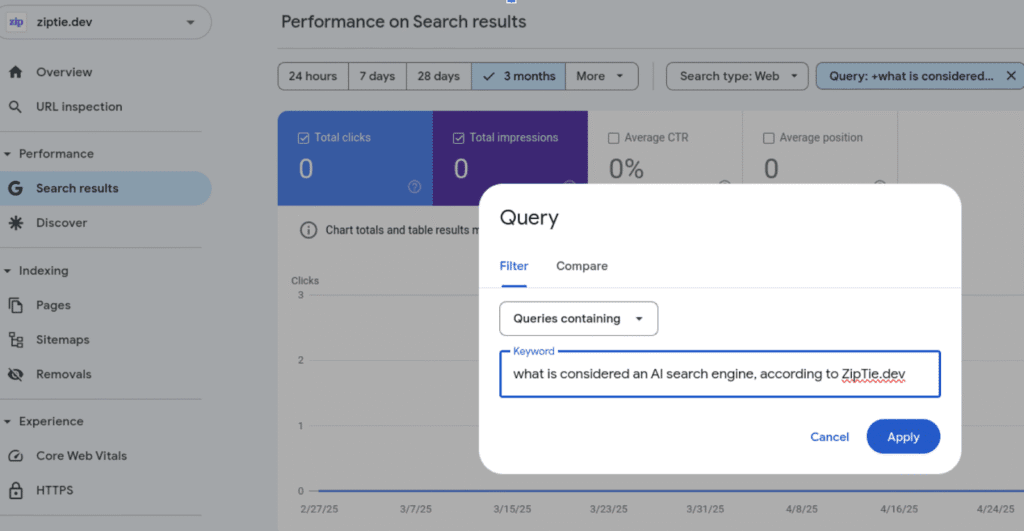Table of Contents


Want to Boost Rankings?
Get a proposal along with expert advice and insights on the right SEO strategy to grow your business!
Get StartedZipTie, a well-known SEO research platform, revealed that Google Search Console (GSC) fails to report nearly 50% of search queries that actually bring users to your site.
Yes, you read that right. It’s been bedrock of measuring organic performance, keyword visibility, and search impressions. But what if we told you that the tool we trust so deeply is only showing us half the picture?
This revelation came to light through a series of real-world experiments led by Tomasz Rudzki, co-founder of ZipTie and respected voice in technical SEO. Their findings are both fascinating and frankly, unsettling.
Free SEO Audit: Uncover Hidden SEO Opportunities Before Your Competitors Do
Gain early access to a tailored SEO audit that reveals untapped SEO opportunities and gaps in your website.

In the age of generative search and AI answers, where Google is increasingly prioritizing human-style questions, how can its own reporting tool miss such critical data?
So, What Exactly Did ZipTie Find?
Rudzki’s investigation began with a simple yet impressive experiment. For several days, he typed the same conversational queries into Google from different devices and accounts, all leading to his own website.
The data gap is not speculative; it’s been methodically tested and verified. Co-founder of ZipTie, revealed in his recent report (see here) that Google Search Console consistently fails to show conversational queries the very way most users now search.
According to Rudzki, approximately 50% of search queries that generate website traffic are completely absent from GSC reports. These are low impact and irrelevant searches. 
These are genuine visits to your site that Google’s own analytics tool is not acknowledging. Think about that half the traffic insight is missing, yet we build entire strategies based on these dashboards.
A Simple Experiment That Revealed a Big Problem
He began by searching a conversational query on Google from multiple devices and different accounts, all directing users to a specific page on his own website.
Using independent analytics tools he confirmed traffic was reaching his site. But when he checked Google Search Console?
“Zero. Nada. Null.”
That was his blunt summary of what showed up in GSC for those exact search terms.
To verify the pattern, Rudzki asked 10 other seasoned SEO professionals to repeat the experiment. They followed the same process. The outcome? Identical. Their conversational search queries brought actual visitors, yet GSC reported none of them.
That’s not a bug. That’s a system-wide blind spot
Why Is Google Ignoring Conversational Queries?
At the heart of the issue lies the evolution of search behavior. People no longer type just “best iPhone 2025” now they ask:
- “What are the pros and cons of the iPhone 16?”
- “Should I buy the new iPhone or stick with Samsung?”
- “Compare iPhone 16 with Samsung S25.”
These are rich, intent-driven, high-value queries the kind that marketers crave.
But here is the twist: Google Search Console seems to have a threshold system. Only queries with a certain volume are deemed worthy of being reported.
As Rudzki’s colleague Jakub Łanda discovered, unless a query passes that magic number, it stays hidden. Even worse once it does cross the threshold, GSC does not backfill the historical data. It’s lost.
This becomes especially problematic when you realize that individually, such conversational variations might have low monthly search volumes, maybe just 10 to 15 searches each. But collectively? Hundreds or even thousands. That is a lot of lost insight.
Meanwhile, Google Can Read These Queries… Just Not Show Them
The irony? Google does understand these natural language queries. In fact, Rudzki analyzed a whopping 140,000 questions pulled from the “People Also Ask” feature.
His discovery: AI Overviews were displayed for 80% of these conversational searches. So Google is more than capable of parsing and answering detailed, spoken-style questions. It even produces AI-powered responses to them.
And yet, for SEO professionals relying on Google Search Console, these same queries might as well not exist.
As Rudzki puts it:
“Google is ready to show the AI answer on conversational queries. Yet, it struggles to report conversational queries in one of the most important tools in SEO’s and marketer’s toolkits.”
What Does This Mean for Marketers
Let’s pause and ask: What does it mean to work in SEO today if the platform we trust for performance tracking hides half the data?
Here is what it really means:
- Content gaps: You are writing based on what keyword tools and GSC show you. But what about the 50% of queries that never appear? These are real searches from real people and you are potentially missing them entirely.
- Misleading performance metrics: A page might look like it is underperforming in GSC but in reality, it is driving substantial traffic via unreported conversational queries.
- Lost trend signals: You can’t see rising trends early if GSC only reveals them after they have already become popular. That is like investing after the stock’s already peaked.
- Faulty strategy alignment: Keyword-first strategies become less effective if user intent hides behind invisible queries.
Is Voice Search the Culprit?
Very likely, yes. Voice search is growing and statistically, around 20% of global internet users now use voice search regularly.
It is how we naturally talk to Alexa, Siri or even Google Assistant. These interactions are question-based, detailed and highly conversational.
With AI and voice interfaces becoming more integrated into daily digital experiences, it makes perfect sense that search patterns are becoming more human. And yet, GSC is still playing catch-up.
So… What Now?
If GSC only shows part of the puzzle, we need to work smarter and broader.
- Switch from Queries to Pages in GSC
Instead of obsessing over search queries that may never appear, look at the “Pages” report in GSC. Which URLs are drawing traffic? This gives you clues about what’s resonating even if the source queries are invisible.
- Go Beyond GSC
Use third-party analytics like Matomo, Clicky or even advanced GA4 tagging to understand traffic sources. Monitor behavior flow, time on page, and user interaction to infer search intent.
- Answer Real Questions
Use forums (Reddit, Quora), customer support logs and internal search data to identify real, natural language questions. Tools like AlsoAsked, AnswerThePublic and ChatGPT can simulate how people phrase things.
- Bundle Variations in Strategy
Don’t just target “best laptops 2025.” Target the whole cluster:
- “What’s the fastest laptop for video editing?”
- “Should I get Mac or Windows for school?”
- “Laptop under $1,000 with best battery life?”
Create pillar content and supporting pages that address variations.
What Does the Future of Google Console Look Like?
Until Google fixes the reporting blind spot in GSC which has not been addressed officially yet — SEO will remain part science, part art.
The gap between how users search (conversational, curious, precise) and how tools report (quantitative, volume-based, outdated) will likely grow.
About the author
Share this article
Find out WHAT stops Google from ranking your website
We’ll have our SEO specialists analyze your website—and tell you what could be slowing down your organic growth.














